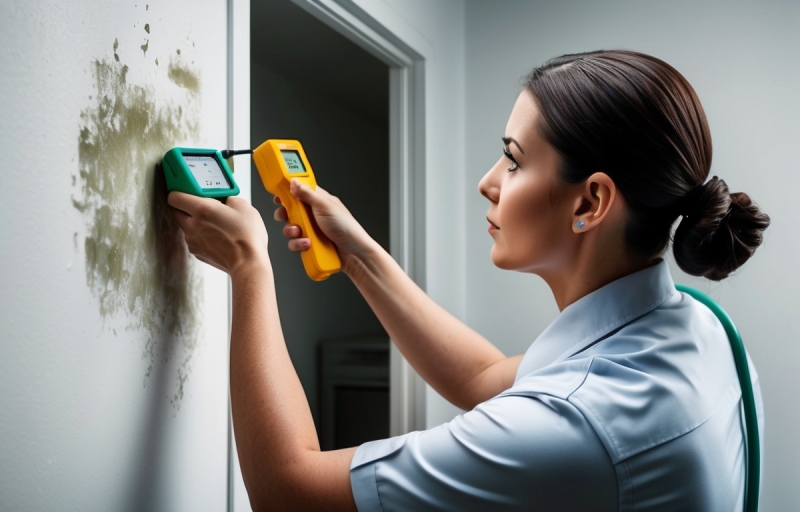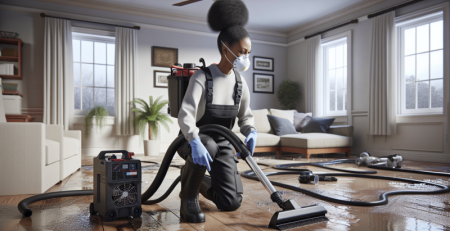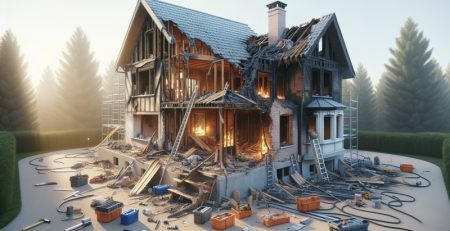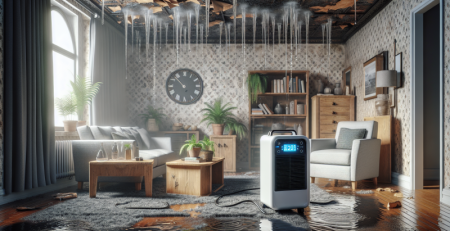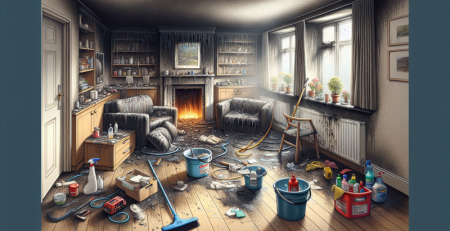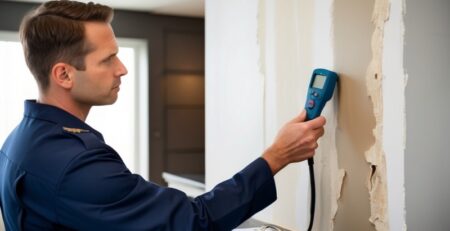How to Spot Mold in Your Homes Walls
Mold growth in your home’s walls can pose serious health risks and structural damage if left unchecked. Recognizing the signs of mold early is crucial for maintaining a safe and healthy living environment. In this guide, we will explore effective methods to spot mold in your walls, including visual indicators and musty odors that signal potential problems. Understanding the conditions that promote mold growth, such as moisture and humidity, is also essential. At Kraus Restoration, NJ’s leaders in water, mold, and fire damage restoration, we emphasize the importance of prompt action. Our IICRC certified experts are available 24/7 to assist you with any mold concerns. Serving Central and Northern NJ, we are committed to providing rapid response solutions. If you suspect mold in your home, don’t hesitate to call us at (973) 886-2021 for professional assistance.
Understanding Mold: What to Look For
Mold is a common issue that can affect homes, particularly in areas with high humidity or moisture. Understanding what to look for when identifying mold in your walls is crucial for maintaining a healthy living environment. Mold can not only damage your property but also pose serious health risks to you and your family. Here are some key indicators to help you spot mold in your home.
First, be aware of the visual signs of mold. Mold can appear in various colors, including black, green, white, or even orange. It often has a fuzzy or slimy texture and can grow in patches. Look for mold growth in areas that are prone to moisture, such as around windows, in bathrooms, under sinks, and in basements. If you notice any discoloration on your walls or ceilings, it could be a sign of mold.
Next, pay attention to any musty odors. Mold produces a distinct smell that is often described as earthy or damp. If you detect a persistent musty odor in your home, it may indicate hidden mold growth behind walls or in other concealed areas. This smell can be particularly strong in enclosed spaces like closets or attics.
Another important factor to consider is the presence of water damage. If you have experienced leaks, flooding, or high humidity levels, your home may be at risk for mold growth. Look for water stains, peeling paint, or warped drywall, as these can be signs of moisture problems that may lead to mold. According to the Environmental Protection Agency (EPA), "mold can grow on virtually any surface where moisture is present."
Additionally, keep an eye on your health. Mold exposure can lead to various health issues, particularly for individuals with allergies, asthma, or compromised immune systems. Symptoms may include sneezing, coughing, skin irritation, and respiratory problems. If you notice a correlation between your health symptoms and specific areas of your home, it may be time to investigate further for mold.
To effectively identify mold, consider conducting a thorough inspection of your home. Here are some steps to guide you:
- Inspect areas prone to moisture, such as bathrooms, kitchens, and basements.
- Check for visible mold growth on walls, ceilings, and floors.
- Look for water stains or discoloration that may indicate past or present moisture issues.
- Smell for musty odors that could suggest hidden mold.
- Monitor your health and note any symptoms that arise in specific areas of your home.
If you suspect mold in your walls, it is essential to act quickly. Mold can spread rapidly, and the longer it is left untreated, the more extensive the damage can become. In many cases, professional mold remediation services may be necessary to ensure that the mold is safely and effectively removed. For more information on how to address mold issues in your home, you can visit our mold cleanup services page.
In conclusion, understanding what to look for when identifying mold in your home is vital for maintaining a safe and healthy living environment. By being vigilant about visual signs, odors, water damage, and health symptoms, you can take proactive steps to address mold issues before they escalate. Remember, if you find mold in your walls, it is crucial to seek professional help to ensure proper remediation. For further assistance, feel free to contact us or learn more about our services.
For additional resources on mold and its effects, you can refer to the EPA’s guidelines on mold and moisture management here.
Common Signs of Mold Growth on Walls
Mold growth on walls is a common issue that many homeowners face, and recognizing the signs early can prevent extensive damage and health risks. One of the most noticeable indicators of mold presence is discoloration on the walls. You may observe patches that appear green, black, or even white, which can vary in texture from fuzzy to slimy. These color changes often indicate that mold is thriving in that area, particularly in damp or humid environments. Another sign to look for is a musty odor. If you notice a persistent, earthy smell in certain rooms, it could be a strong indication that mold is growing behind or on the walls, even if it is not immediately visible.
In addition to visual and olfactory clues, peeling or bubbling paint and wallpaper can also signal mold growth. When mold develops underneath these surfaces, it can cause them to lose adhesion and begin to lift away from the wall. This not only affects the aesthetics of your home but can also lead to further damage if left unaddressed. Furthermore, if you find moisture or condensation on your walls, it is crucial to investigate further. Excess moisture creates an ideal environment for mold to flourish, and spotting water stains or damp patches can be a clear sign that mold is likely present.
Another common sign of mold growth is the presence of water stains or discoloration that may appear as brown or yellow spots. These stains often indicate that there has been a leak or water intrusion, which can lead to mold if not properly managed. If you notice any of these signs, it is essential to take action promptly. Ignoring mold growth can lead to more significant problems, including structural damage to your home and potential health risks for you and your family.
If you suspect mold in your home, it is advisable to consult professionals who specialize in mold cleanup. They can conduct a thorough inspection and provide the necessary remediation services to ensure your home is safe and healthy. Additionally, maintaining proper ventilation and controlling humidity levels in your home can help prevent mold growth in the first place. Regularly checking areas prone to moisture, such as bathrooms and basements, can also help you catch any issues before they escalate.
In conclusion, being vigilant about the signs of mold growth on your walls is crucial for maintaining a healthy living environment. By recognizing discoloration, musty odors, peeling paint, and water stains, you can take proactive steps to address mold issues. If you need assistance, do not hesitate to reach out to experts in mold remediation. For more information on our services, visit our services page or contact us directly through our contact page. Taking these steps can help ensure your home remains a safe haven for you and your family.
Tools and Techniques for Detecting Mold
Detecting mold in your home’s walls is crucial for maintaining a healthy living environment. Mold can lead to various health issues and structural damage if left unchecked. Fortunately, there are several effective tools and techniques available to help homeowners identify mold growth early. One of the most common methods is visual inspection. Start by examining areas prone to moisture, such as bathrooms, kitchens, and basements. Look for discoloration, dark spots, or fuzzy growth on walls, ceilings, and around windows. Pay special attention to corners and behind furniture where moisture can accumulate unnoticed.
In addition to visual inspection, using a moisture meter can provide valuable insights into hidden mold problems. These devices measure the moisture content in building materials, helping you identify areas that may be conducive to mold growth. A reading above 20 percent typically indicates a moisture problem that needs addressing. For more thorough investigations, consider using an infrared camera. This technology detects temperature differences in walls, which can indicate moisture intrusion and potential mold growth behind the surface.
Another effective technique is to utilize mold test kits available at hardware stores. These kits allow you to collect samples from suspected mold areas and send them to a laboratory for analysis. While this method can confirm the presence of mold, it is often more practical to combine it with other detection methods for a comprehensive assessment.
If you suspect a significant mold problem, it may be wise to consult professionals who specialize in mold cleanup. They have access to advanced tools and techniques, including air sampling and surface testing, to accurately assess the extent of mold contamination. Professional services can also provide remediation solutions to effectively eliminate mold and prevent future growth.
In addition to these methods, maintaining proper ventilation in your home can help prevent mold growth. Ensure that areas prone to moisture are well-ventilated, and consider using dehumidifiers in damp spaces. Regularly checking for leaks in plumbing and roofing can also help you stay ahead of potential mold issues.
By employing these tools and techniques, you can effectively detect mold in your home’s walls and take appropriate action to safeguard your health and property. For more information on how to protect your home from mold and other environmental hazards, visit our about page or explore our services for comprehensive solutions.
Areas of Your Home Most Prone to Mold
Mold is a common issue that can affect various areas of your home, often leading to health problems and structural damage if left unchecked. Understanding the areas most prone to mold growth is crucial for homeowners looking to maintain a safe and healthy living environment. One of the primary locations where mold thrives is in damp areas, particularly those that experience high humidity or water exposure. Bathrooms are notorious for mold growth due to the frequent use of water and steam from showers. The combination of warmth and moisture creates an ideal breeding ground for mold spores, which can settle on surfaces such as tiles, grout, and even behind walls if leaks occur.
Kitchens are another hotspot for mold, especially around sinks, dishwashers, and refrigerators. Water leaks from plumbing or condensation can lead to mold growth under cabinets or behind appliances. It is essential to regularly check these areas for any signs of moisture or leaks to prevent mold from taking hold. Additionally, basements and crawl spaces are often damp and poorly ventilated, making them prime candidates for mold infestation. These areas can accumulate moisture from groundwater, humidity, or even flooding, which can lead to significant mold problems if not addressed promptly.
Attics can also be susceptible to mold, particularly if there are issues with ventilation or insulation. Poorly insulated attics can trap heat and moisture, creating an environment conducive to mold growth. Homeowners should ensure that their attics are well-ventilated and that any signs of leaks from the roof are repaired immediately. Furthermore, areas around windows and doors can be prone to mold due to condensation that forms when warm air meets cold surfaces. Regularly inspecting these areas for moisture and ensuring proper sealing can help mitigate mold risks.
Another often-overlooked area is the laundry room, where moisture from washing machines and drying clothes can accumulate. It is vital to keep this space well-ventilated and to promptly address any leaks or spills. Lastly, indoor plants can also contribute to mold growth if overwatered or if their pots do not have proper drainage. Mold can develop in the soil or on the leaves, so it is essential to care for indoor plants properly.
To effectively combat mold in your home, it is crucial to maintain low humidity levels, ensure proper ventilation, and address any water damage immediately. Regular inspections of these vulnerable areas can help you spot mold before it becomes a more significant issue. If you do discover mold, it is advisable to seek professional assistance to ensure thorough cleanup and remediation. For more information on how to manage mold in your home, you can visit our mold cleanup services page. Additionally, if you are dealing with water damage that may lead to mold growth, our water cleanup services can help restore your home to a safe condition. For any inquiries or to schedule a consultation, feel free to contact us. By being proactive and informed about the areas most prone to mold, you can protect your home and your health.
Health Risks Associated with Mold Exposure
Mold exposure can pose significant health risks, particularly for individuals with pre-existing respiratory conditions, allergies, or weakened immune systems. When mold spores are inhaled or come into contact with the skin, they can trigger a range of health issues. Common symptoms associated with mold exposure include nasal congestion, coughing, sneezing, throat irritation, and skin rashes. For those with asthma or other respiratory diseases, mold can exacerbate symptoms, leading to increased difficulty in breathing and more frequent asthma attacks.
In addition to respiratory issues, mold exposure can also lead to more severe health complications. Prolonged exposure to mold can result in chronic sinusitis, a condition characterized by persistent inflammation of the sinuses. Some studies have suggested a link between mold exposure and the development of respiratory infections, particularly in children and the elderly. Furthermore, certain types of mold, such as black mold, produce mycotoxins that can lead to more serious health problems, including neurological symptoms and immune system suppression.
Individuals with weakened immune systems, such as those undergoing chemotherapy or living with HIV/AIDS, are particularly vulnerable to the effects of mold. For these individuals, even a small amount of mold can lead to serious infections that may require medical intervention. It is essential for anyone experiencing symptoms related to mold exposure to seek medical advice promptly.
Moreover, the presence of mold in homes can also have psychological effects. The stress of dealing with mold issues, combined with the potential health risks, can lead to anxiety and decreased quality of life. It is crucial to address mold problems quickly and effectively to mitigate these risks.
To protect yourself and your family from the health risks associated with mold, it is important to be proactive in identifying and addressing mold growth in your home. Regular inspections of areas prone to moisture, such as bathrooms, kitchens, and basements, can help catch mold early. If you suspect mold is present, it is advisable to consult with professionals who specialize in mold cleanup to ensure safe and thorough remediation.
In conclusion, understanding the health risks associated with mold exposure is vital for maintaining a safe and healthy living environment. By being vigilant and taking appropriate action, you can protect yourself and your loved ones from the harmful effects of mold. If you need assistance or more information about mold issues in your home, consider reaching out through our contact page for expert guidance and support.
Steps to Take if You Find Mold
Discovering mold in your home can be a concerning experience, but taking the right steps can help you manage the situation effectively. First and foremost, it is essential to prioritize your safety. If you suspect that the mold is extensive or if you have health concerns, consider contacting a professional mold remediation service. They have the expertise and equipment necessary to handle mold safely and effectively. If you decide to tackle the issue yourself, ensure you wear protective gear, including gloves, goggles, and a mask, to prevent inhalation of mold spores.
Once you have taken safety precautions, the next step is to identify the source of moisture that is contributing to mold growth. Mold thrives in damp environments, so it is crucial to address any leaks or water damage. Check for plumbing issues, roof leaks, or condensation problems. Fixing these issues will not only help eliminate existing mold but also prevent future growth.
After addressing the moisture source, you can begin the cleanup process. For small areas of mold, you can use a mixture of water and detergent to scrub the affected surfaces. Ensure you dry the area thoroughly after cleaning, as moisture can lead to mold returning. For larger infestations, it is advisable to consult with professionals who specialize in mold cleanup. They can assess the extent of the problem and provide a comprehensive plan for remediation.
When cleaning mold, it is important to remove any contaminated materials that cannot be salvaged, such as drywall or carpeting. These materials can harbor mold spores and contribute to ongoing issues. Dispose of these items properly, sealing them in plastic bags to prevent spores from spreading during removal.
After the cleanup, consider taking preventive measures to reduce the likelihood of mold returning. This may include improving ventilation in your home, using dehumidifiers in damp areas, and regularly inspecting your home for signs of moisture or mold. Keeping your home dry and well-ventilated is key to preventing mold growth.
If you have any concerns about the health effects of mold exposure, consult with a healthcare professional. Symptoms can vary from mild allergic reactions to more severe respiratory issues, especially for individuals with pre-existing conditions.
In summary, finding mold in your home requires prompt action. Prioritize safety, identify and fix moisture sources, clean affected areas, and consider professional help for extensive mold problems. By taking these steps, you can effectively manage mold issues and maintain a healthy living environment. For more information on how to protect your home from mold and other restoration services, visit our services page or contact us directly through our contact page.
Preventive Measures to Keep Mold at Bay
Mold can be a persistent problem in homes, particularly in areas that are prone to moisture. To effectively prevent mold growth, it is essential to implement a series of proactive measures that address the underlying causes of mold proliferation. One of the most critical steps is to control humidity levels within your home. Ideally, indoor humidity should be maintained between 30 and 50 percent. Utilizing dehumidifiers in damp areas such as basements and bathrooms can significantly reduce moisture levels. Additionally, ensuring proper ventilation in these spaces is vital. Installing exhaust fans in bathrooms and kitchens can help expel humid air, while opening windows when weather permits allows for fresh air circulation.
Another important preventive measure is to promptly address any leaks or water damage. Regularly inspect your home for signs of water intrusion, such as stains on walls or ceilings, and repair any leaks in plumbing or roofing immediately. If you notice any water damage, it is crucial to dry the affected area within 24 to 48 hours to prevent mold from taking hold. This can involve using fans, dehumidifiers, or even professional water cleanup services if the damage is extensive. For more information on how to handle water damage, you can visit our water cleanup services page.
In addition to managing humidity and addressing leaks, it is beneficial to maintain a clean home. Regular cleaning can help eliminate mold spores before they have a chance to settle and grow. Pay special attention to areas that are often overlooked, such as behind appliances, under sinks, and in corners. Using mold-resistant products, such as paints and drywall, can also provide an extra layer of protection against mold growth. These materials are designed to inhibit mold development and can be particularly useful in high-moisture areas.
Another effective strategy is to ensure that your home’s exterior is well-maintained. This includes cleaning gutters regularly to prevent water from pooling around the foundation and ensuring that landscaping directs water away from the home. Proper drainage systems can help keep moisture levels low around your property. Additionally, sealing windows and doors can prevent moisture from entering your home, further reducing the risk of mold growth.
If you live in a particularly humid climate, consider investing in a whole-house dehumidifier. This system can help regulate humidity levels throughout your home, providing a consistent environment that is less conducive to mold growth. Furthermore, using air conditioning can also help reduce humidity levels, as it cools the air and removes moisture in the process.
For those who are particularly sensitive to mold or have existing mold issues, it may be wise to conduct regular inspections of your home. Look for signs of mold growth, such as discoloration on walls or ceilings, and be vigilant in checking areas that are prone to moisture. If you suspect mold is present, it is best to consult with professionals who specialize in mold cleanup to ensure that it is safely and effectively removed.
In summary, preventing mold in your home requires a multifaceted approach that includes controlling humidity, addressing leaks, maintaining cleanliness, and ensuring proper ventilation. By taking these preventive measures, you can significantly reduce the likelihood of mold growth and create a healthier living environment for you and your family. If you have any concerns or need assistance with mold prevention or cleanup, do not hesitate to reach out through our contact page for expert guidance and support.
In conclusion, spotting mold in your home’s walls is crucial for maintaining a healthy living environment. By being vigilant and aware of the signs of mold growth—such as discoloration, musty odors, and moisture issues—you can take proactive steps to address the problem before it escalates. Regular inspections, proper ventilation, and immediate action at the first sign of mold can help protect your home and your health. If you do discover mold, don’t hesitate to seek professional help to ensure thorough removal and remediation. Remember, a clean and mold-free home is not just about aesthetics; it’s about creating a safe space for you and your loved ones. Stay informed, stay proactive, and keep your home mold-free!
